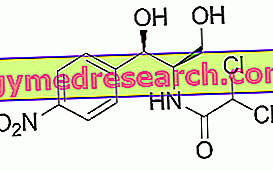Chloramphenicol is an antibiotic of natural origin with a bacteriostatic action (ie it inhibits the growth of bacterial cells). It was obtained for the first time from the fermentation of Streptomyces venezuelae, but - given the simplicity of its chemical structure - nowadays it is totally produced synthetically.

Chloramphenicol - Chemical Structure
Chloramphenicol is marketed in pharmaceutical forms suitable for vaginal, ocular and intravenous administration routes.
Indications
For what it uses
Chloramphenicol is used to treat infections caused by microorganisms sensitive to it.
The use of chloramphenicol is indicated for the treatment of:
- Gynecological infections, such as vaginitis, cervicitis or cervico-endometritis (vaginal administration);
- External eye infections, such as conjunctivitis, keratitis, keratoconjunctivitis, trachoma or dacryocystitis (ocular administration);
- Prevention of eye infections associated with mechanical or thermal trauma (ocular administration);
- Pre and post-surgical treatment of eye infections (ocular administration);
- Typhoid fever and salmonellosis (parenteral administration);
- Bacterial meningitis (parenteral administration);
- Rickettsiosi (parenteral administration);
- Brucellosis (parenteral administration);
- Psittacosis (parenteral administration);
- Venereal lymphogranuloma (parenteral administration);
- Urinary infections caused by Gram-negative (parenteral administration);
- Infections with anaerobic bacteria, such as Gram-positive cocci or Clostridium (parenteral administration).
Warnings
Chloramphenicol should only be administered for the amount of time actually needed. It is preferable not to exceed two weeks of treatment.
During treatment with chloramphenicol it is necessary to carry out regular checks on blood counts, since the drug can cause myelosuppression (ie suppression of the bone marrow, with a consequent decrease in the production of blood cells).
Cases of bone marrow hypoplasia have been reported during treatment with chloramphenicol via the ocular or vaginal route.
Chloramphenicol can cause a decrease in prothrombin time, since the antibiotic itself can inhibit the intestinal bacterial flora that produces vitamin K.
In patients with hepatic and / or renal insufficiency it may be necessary to adjust the chloramphenicol dose to be administered.
Treatment with chloramphenicol may favor the development of superinfections with resistant bacteria or fungi.
Chloramphenicol can cause false positives in a particular type of test used to determine urine glucose.
Interactions
Chloramphenicol is an inhibitor of the hepatic cytochrome P450, therefore, it can cause an increase in the plasma half-life of drugs metabolized by it, with a consequent increase in their toxicity. These drugs include:
- Warfarin, an oral anticoagulant;
- Clopidogrel, a platelet antiplatelet;
- Vorioconazole, an antifungal;
- Cyclophosphamide, an anticancer;
- Ciclosporin and tacrolimus, immunosuppressive drugs used in the prevention of rejection in transplants;
- Phenobarbital, a barbiturate;
- Rifampicin, an antibiotic.
Paracetamol can increase the toxicity of chloramphenicol.
With the simultaneous administration of beta-lactam antibiotics and chloramphenicol, an antagonism can occur between the two types of antibiotics.
Chloramphenicol may decrease the effect of cyanocobalamine (a derivative of vitamin B12).
Chloramphenicol can decrease the biliary excretion of entacapone (a drug used in the therapy of Parkinson's disease), thus increasing its toxicity.
Chloramphenicol may potentiate the effect of hypoglycemic sulfonamides .
Chloramphenicol inhibits the intestinal absorption of methotrexate, an anticancer medicine.
The concomitant use of chloramphenicol and other drugs with myelosuppressive action should be avoided.
Chloramphenicol may interfere with immunity mechanisms and should not be administered during the active immunization phase; for example, it should not be given concomitantly with the live typhoid vaccine.
Side effects
Chloramphenicol can cause various side effects, although not all patients experience them. The type of adverse effects and the intensity with which they occur depend on the sensitivity that each individual has towards the drug. Therefore, it is said that the undesirable effects do not occur all with the same intensity in each person.
The main adverse effects that may occur during chloramphenicol therapy are listed below.
Myelosuppression
Chloramphenicol may have a depressive effect on the bone marrow. This depression results in a decrease in blood cell production which, in turn, can lead to:
- Agranulocytosis, ie a decrease in the number of granulocytes in the bloodstream;
- Leukopenia, ie the reduction in the number of leukocytes in the bloodstream;
- Anemia;
- Reticulocytopenia, ie the decrease in the number of reticulocytes in the blood;
- Piastrinopenia, ie the decrease in the number of platelets in the bloodstream;
- Aplastic anemia.
Chloramphenicol-induced myelosuppression is more common in patients with hepatic and / or renal insufficiency.
Gray baby syndrome
This syndrome can affect newborns whose mothers have taken chloramphenicol intravenously during the final stages of pregnancy or newborns who have been given large amounts of antibiotics parenterally. This syndrome - which can also have fatal outcomes - is characterized by symptoms such as hypothermia, vomiting, ashy color, progressive cyanosis and circulatory collapse.
Gastrointestinal disorders
Treatment with chloramphenicol may cause:
- Nausea;
- He retched;
- Alterations in the sense of taste;
- Diarrhea;
- Enterocolitis;
- Stomatitis;
- Glossitis.
Nervous system disorders
Chloramphenicol-based therapy can cause:
- Headache;
- Mental confusion;
- Optic or peripheral neuropathy.
Psychiatric disorders
Treatment with chloramphenicol may cause delirium and mild depression.
Allergic reactions
Chloramphenicol can trigger allergic reactions in sensitive individuals. These reactions can occur with symptoms, such as:
- Temperature;
- Skin eruptions;
- Urticaria;
- Vesicular or maculopapular dermatitis;
- Angioedema;
- Anaphylaxis.
Other side effects
Other side effects that may occur during treatment with chloramphenicol are:
- Perineal irritation;
- ototoxicity;
- Hepatotoxicity;
- Jarisch-Herxheimer reaction, a reaction that occurs when large amounts of toxins are released into the body resulting from damage to bacterial cells following antibiotic therapy. This reaction is characterized by symptoms such as headache, chills and mucocutaneous lesions.
Overdose
Cases of chloramphenicol overdose have been reported only when the drug was administered intravenously, but this does not exclude possible overdoses even when chloramphenicol is taken vaginally or ocularly.
If you suspect any type of overdose, you must inform your doctor immediately and go to the nearest hospital.
In the case of intravenous administration of chloramphenicol, hemodialysis or peritoneal dialysis may be only partially effective in eliminating excess drug from the bloodstream. In cases of overdoses in newborns complete transfusions or coal-based fusion can be used.
Action mechanism
Chloramphenicol has a bacteriostatic type of antibiotic action and acts by inhibiting bacterial protein synthesis.
Protein synthesis in bacterial cells takes place thanks to organelles called ribosomes. These organelles consist of ribosomal RNA and proteins associated with each other to form two subunits: the 30S subunit and the 50S subunit.
The task of the ribosome is to translate the messenger RNA from the cell nucleus and to synthesize the proteins for which it encodes.
Chloramphenicol is able to bind to a specific site present on the 50S ribosomal subunit. In doing so, it stops protein synthesis and inhibits bacterial cell growth.
Mode of Use - Posology
Chloramphenicol is available for:
- Vaginal administration in the form of eggs;
- Administration by eye in the form of eye drops or ophthalmic ointment;
- Intravenous administration in the form of powder and solvent for solution for injection which must be mixed just before the use of the drug.
Vaginal administration
It is recommended that an ovum (containing 500 mg of chloramphenicol) be introduced deeply into the vagina in the evening before bedtime. Generally, the duration of treatment is ten days.
Ocular administration
It is advisable to instill one or two drops of eye drops 3-4 times a day or as prescribed by the doctor.
Ophthalmic ointment should be applied 3-4 times a day.
If eye drops have been prescribed together with the ointment, then a single evening application is sufficient.
Intravenous administration
In adults and adolescents, the dose of chloramphenicol usually used is 50-100 mg / kg of body weight per day, to be divided into four administrations at intervals of six hours from each other.
In infants over two weeks of age and in children up to 12 years of age, the dose of chloramphenicol usually administered is 50 mg / kg of body weight per day, to be taken in four divided doses with an interval of six hours between one administration and the other.
In infants up to two weeks of age, the dose of chloramphenicol usually used is 25 mg / kg of body weight per day, to be divided into four administrations at intervals of six hours from each other.
In infants less than one week old and with a body weight of less than 2 kg, the dose of chloramphenicol usually administered is 25 mg / kg of body weight in a single daily dose.
In neonates over one week old and with a body weight of more than 2 kg, the recommended dose of chloramphenicol is 25 mg / kg of body weight per day, to be divided into two administrations at a distance of twelve hours each other.
Patients with reduced renal and / or hepatic function may need to adjust the dose of chloramphenicol administered.
Pregnancy and breastfeeding
Cases have been reported in which newborns, whose mothers took chloramphenicol parenterally in the final stages of pregnancy, developed the gray child syndrome with sometimes fatal results. Therefore, the use of chloramphenicol by pregnant women should be carried out only in cases of real need and only under the strict supervision of the doctor.
Chloramphenicol is excreted in breast milk, although in minimal quantities. However, the possible onset of gray child syndrome cannot be ruled out. Furthermore, chloramphenicol can induce infantile myelosuppression. Therefore, the use of the drug by mothers who are breast-feeding should be avoided.
Regarding the use of chloramphenicol administered vaginally or ocularly, pregnant women and breastfeeding mothers should seek absolute medical advice before taking these drugs, due to the potential adverse effects that can occur in the fetus or infant.
Contraindications
The use of chloramphenicol is contraindicated in the following cases:
- Known hypersensitivity to chloramphenicol itself;
- In patients with bone marrow depression;
- During lactation (when chloramphenicol is administered parenterally).
Furthermore, chloramphenicol should not be used to treat mild infections or prophylaxis therapies.



